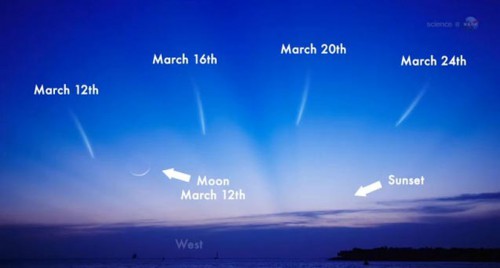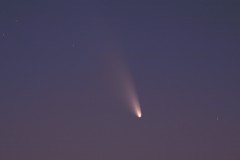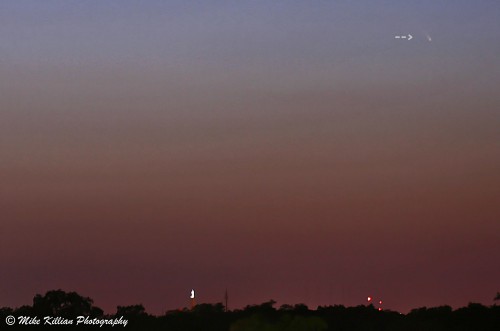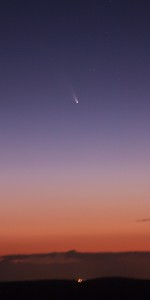Comet PanSTARRS visits the inner solar system this month, possibly becoming bright enough to see with the naked eye. Video Credit: ScienceAtNASA
Comet C/2011 L4, better known as PanSTARRS, made its debut in the skies of the northern hemisphere this week. The comet, however, is proving to be much more difficult to spot than many people had expected—at least so far.
PanSTARRS was discovered in 2011 by astronomers using the Panoramic Survey Telescope and Rapid Response System (PAN-STARRS), which is located high atop the Haleakala volcano in Hawaii. The comet was first visible to southern hemisphere observers for several weeks, and this week the comet is beginning to make its presence known to those of us located north of the equator.

For those of us at mid-northern latitudes, the best opportunity to see the comet may be this evening. PanSTARRS will reveal itself in the western twilight next to a thin crescent moon, a rare sight that Earth may not see again for many centuries. Look to the west 30 minutes after sunset, and the crescent moon low on the horizon should provide a great reference point from which to spot the comet, which will appear just to the left of the moon. Depending on your local sky conditions, your window of opportunity to see the comet may be only 15-40 minutes or so, as PanSTARRS will dip below the horizon as fast as the twilight fades to darkness.
This moon / comet dance across the western twilight sky will continue for a few days, with the two celestial bodies appearing further and further apart with each passing night.

Having a pair of binoculars available to spot the comet may be the difference between seeing PanSTARRS and not seeing it at all. Reports from high-altitude locations with minimal haze confirm sightings through binoculars and telescopes, but most reports currently confirm widespread difficulty in seeing the comet at all across the continental United States, so far.
Over the next week, PanSTARRS will gradually appear higher above the horizon each evening, making a northward trek across the twilight dusk skies over the course of the month. Its “higher” location above the horizon each night will put it in darker skies as it appears higher above the twilight, but that does not necessarily mean it will become easier to spot. The comet is now moving away from the Sun and back out into the solar system, becoming dimmer as it pushes further out into space.
The comet made its closest approach to the Sun this past Sunday, diving inside the orbit of planet Mercury and coming within 28 million miles of the Sun’s surface. The difficulty in observing PanSTARRS this past weekend was due to its close proximity to the Sun, with the Sun’s glare at twilight being too overwhelming to allow worthwhile observations. NASA officials expect to see the comet become easier to view starting this evening, as PanSTARRS creates more distance between it and the Sun with each passing night.
— Photographing A Once-In-A-Lifetime Visitor
PanSTARRS truly is a once-in-a-lifetime visitor to our neighborhood—it will not appear in our skies again for 100,000+ years, if ever. In fact, this is the comet’s first visit to the inner solar system, and this week’s moon / comet dance will provide a very unique photo-op for those with clear skies on the western horizon.

Even with the comet currently being difficult to spot with the naked eye, photographers are capturing some nice images of PanSTARRS using long-exposures. A long-exposure of 5-10 seconds should bring the comet into view, starting 30-40 minutes after sunset. A telephoto lens is obviously a must, as is the use of a DSLR camera on a tripod. A shutter-release cable is preferred to avoid any camera shake caused by clicking the shutter button on the camera itself, although using the camera’s built-in timer would work as well.

Focus to infinity and frame your shot on the horizon, remembering that PanSTARRS will be located at a point just to the left of the crescent moon this evening. Even if you cannot see the comet yourself remember it is there, and a long-exposure will bring it into view. A low ISO (200 or so) is always preferred to avoid introducing too much noise into the photo, and open your aperture as wide as your lens will allow (smallest F-number). This is a good starting point to begin shooting. Adjust your exposure times until you find what works for you, as the lighting and sky conditions will vary from one location to the next.
The moon will only be illuminated to a factor of 2 percent, so a longer exposure should not be too difficult to pull off, but again adjust your exposure times and ISO accordingly until you find a setting you like which brings the comet into view without the moon light and twilight drowning out the comet. Adjusting your White Balance (WB) will also change the “color” of your image. A Tungsten WB will capture a blue-ish twilight, a White Fluorescent WB will capture a more maroon / purple twilight, and an Shade or Cloudy WB will capture a more reddish scene.
— Year Of The Comet
If you are unable to see comet PanSTARRS on the sunset horizon this month, don’t worry too much, because this is just a taste of what could be in store for us later this year. Another comet, known as C/2012 S1 (aka ISON), will come into view during the dawn hours in late November and will remain in view through December. ISON is favored for view to us in the northern hemisphere, but should be visible to some extent around the globe.
Comets are notoriously unpredictable, but some astronomers have expressed optimism that ISON has potential to become the “comet of the century” if the Sun does not pull it apart. Best case scenarios suggest the comet’s brightness during it’s closest approach to the Sun on November 28 could rival that of the daytime full moon, displaying a long bright tail and becoming visible even in the daytime. Only time will tell; ISON could also break apart completely as it heats to upwards of 2900º K, which is hot enough to melt iron and lead, as it dives to within just 800,000 miles of the Sun’s surface, leaving nothing left to be seen.
— If you capture photos of PanSTARRS in the western twilight sky and would like to share for possible publication for our viewers to see, please feel free to share them on our Facebook page by clicking HERE!



